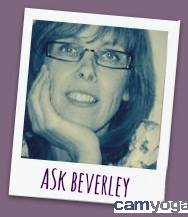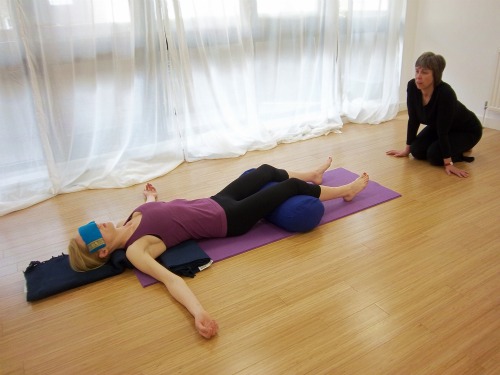Beverley Nolan Answers Your Questions on Yoga for Women's Health
 Q1) Sometimes I feel like my hormones rule my life! Can you recommend any poses to help me to feel more balanced?
BEVERLEY: Hormones are chemical messengers in the body that are secreted by glands and certain cell clusters in response to internal and external stimuli. I like to think of these happenings as conversations in my body that I overhear by experiencing changes in my moods and emotions. When the conversation is loud and disturbing, we can be overwhelmed by the drama and be praying for it to be over, but at this time it is incredibly useful to engage wholeheartedly with what is going on and not to plough on regardless. First and foremost, I recommend establishing a dialogue with the body. It is easier than it might seem: you simply ask what the body needs and give room for your innate wisdom to reply. It could be anything from a particular food, a particular pose or activity, spending time alone or in company – anything, be prepared to be surprised! In terms of specific yoga practices, Mindfulness in all things can reduce any disturbing feelings of being out of control and certainly Supported Reclined Bound Angle Pose (Salamba Supta Badha Konasana) is a peach, as it promotes overall rest but importantly bring space to the pelvic organs and glands. (NB – emotions are not the exclusive domain of women – so I would encourage men to have body-conversations, practice Mindfulness and Salamba Supta Badha Konasana too!)
Q1) Sometimes I feel like my hormones rule my life! Can you recommend any poses to help me to feel more balanced?
BEVERLEY: Hormones are chemical messengers in the body that are secreted by glands and certain cell clusters in response to internal and external stimuli. I like to think of these happenings as conversations in my body that I overhear by experiencing changes in my moods and emotions. When the conversation is loud and disturbing, we can be overwhelmed by the drama and be praying for it to be over, but at this time it is incredibly useful to engage wholeheartedly with what is going on and not to plough on regardless. First and foremost, I recommend establishing a dialogue with the body. It is easier than it might seem: you simply ask what the body needs and give room for your innate wisdom to reply. It could be anything from a particular food, a particular pose or activity, spending time alone or in company – anything, be prepared to be surprised! In terms of specific yoga practices, Mindfulness in all things can reduce any disturbing feelings of being out of control and certainly Supported Reclined Bound Angle Pose (Salamba Supta Badha Konasana) is a peach, as it promotes overall rest but importantly bring space to the pelvic organs and glands. (NB – emotions are not the exclusive domain of women – so I would encourage men to have body-conversations, practice Mindfulness and Salamba Supta Badha Konasana too!)
Q2) Do you have any recommendations for practices for the perimenopause stage of life, perhaps looking to help ease into the menopause itself? BEVERLEY: All that is certain is that perimenopause is a time of a physiological remapping similar in power and impact to the onset of menses in adolescence, and for some women the experience of pregnancy, birthing and motherhood. It is a metamorphosis that may go lightly or tempestuously but either way it is unavoidably made. It is a time of deep intimate conversation with your very identity. For many women, the quieter practices of Restorative Yoga, Yin Yoga, Gentle Hatha and Slow Flow are helpful to ease the physical symptoms and give time for self-reflection, but sometimes there is a fantastic wildness to the transition that generates a sudden surge and flow energy and creativity and this can be embodied by revisiting old challenges or seeking new ones. Every woman is different, but again establishing a dialogue with the body is key to navigating the changes that will reshape your identity.
Q3) Lots of teachers have different ideas about whether it's ok to do inversions while menstruating. What do you think? BEVERLEY: True! I think there are mainly two strands to the opinion that inversions should not be practiced. One is based on the energetics of the pranic system that indicates that ‘apana’, a specific flow of prana located between the navel and the perineum, by its essential nature is downward and outward flowing and that the menstrual flow is an embodiment of this. The second is based on an assumption that retro-flow presents a risk of endometriosis, a condition where cells from the womb lining are found outside of the womb in the abdominal cavity, for example. To the best of my knowledge there is no definitive clinical evidence to prohibit inversions during menstruation. My own recommendation is once again to tune into the body and the symptoms that are presenting and follow the specific needs that arise – it’s as simple as asking “do I really want to turn upside down today?”. To be honest, most women I work with more often than not really don’t want to turn upside down and welcome the chance to do something else in class. What we need to be careful of as teachers is honouring the need for some women to maintain discretion around menses in the class situation, and maintaining inclusivity during any alternative practices.
Q4) Is yoga historically a men's practice or have women always done it too? BEVERLEY: We have to remember that surviving documents and archaeological fragments are only a glimpse into the history of humanity’s search into the nature of being. It is true to say that many of the images and stories that have survived depict more male than female participants; but it is certainly not exclusive. I would imagine that along with many culture and traditions the Divine Feminine and the role of woman in understanding the nature of being will have at times been revered and encouraged, and at times will have suffered from the rise and dissemination of partriarchal influence. The important thing to remember is that Love is completely unconditional, completely unjudgemental and in fact totally indifferent to gender, and it is Love that lies at the heart of it all.
Q5) How often should I practice yoga?
BEVERLEY:This question comes form mind – answer it with your heart and you won’t be wrong!
Beverley Nolan is one of the region's most beloved teachers and a member of Camyoga's prestigious teacher training faculty. Find out more here


